Now it's absolutely certain: Vladimir Korotkevich is our everything. No figure in Belarusian literature and art as a whole attracts such interest from readers and authors. Korotkevich is quoted, Korotkevich is staged on the opera stage in Minsk and London in two different versions, Korotkevich is excluded from the school curriculum... Finally, he is transformed into a play at the Republican Theater of Belarusian Drama.
Judging by the speed of sold-out tickets and the enthusiasm of the audience, "Karney: The Story of One House" directed by Alena Zmiter can perhaps claim the honorary title of "Production of the Year 2023" in Belarusian theater. At least, in the theater that operates within the Republic of Belarus. Fortunately, to most viewers, Vladimir Korotkevich's short parable "Karney – Mouse Death," spanning about ten pages, is almost unknown.

Against the backdrop of Korotkevich's major works, "Karney" may seem small and even trivial at first glance. But, as it turns out, the author managed to pack much more into fewer than twenty thousand characters than other authors do in giant volumes.
The parable was published in 1961, and the young author used the archetypal European plot of the Pied Piper, a rat-catcher, who eventually leaves the medieval town of Hamelin with the children of its greedy burghers. The events of "Karney" unfold in Belarus and touch upon wartime experiences. Korotkevich presents a clearly fairy-tale plot through the eyes of a child, yet he embeds it in the context of the recent Nazi occupation, encapsulated in the significant phrase "genocide of the Belarusian people." But his parable remains just that, a parable.

It seems that the conventionality of Korotkevich's text and the potential for interpretations were also felt at the Minsk Republican Theater of Belarusian Drama. Korotkevich has been brought to the stage, and from a short story, a large multifaceted play of two and a half hours has emerged – the original work can be read in just a few minutes. The creators of the adaptation, Nikolai Muzychenko and director Alena Zmiter, have turned the brief text into almost an epic about the fate of the Belarusian nation. "Karney: The Story of One House" is not a typical adaptation of a prose text for the theatrical stage but a full-fledged attempt to address a relevant topic using literary classicism.

In Vladimir Korotkevich's version, the infernal rat-catcher Karney appears as a rural eccentric, a friend of children, and a victim of circumstances. In the interpretation led solely by Denis Avkharenko, Karney the rat-catcher resembles Stalker from Andrei Tarkovsky's film, played by Alexander Kaidanovsky – an unusual, externally insecure individual who possesses immense inner strength nonetheless. Karney is engaged in a strange and rare rural occupation – ridding houses of rodents using herbs and incantations. People consider him a local fool, but he doesn't fit into village society himself; he keeps his distance, speaks and moves strangely, and looks peculiar. Only children communicate with him on equal terms. Moreover, Karney himself is a true big child, observing the world with wide-open, amazed eyes. A peculiar individual, who, as it turns out, sees much more than others.
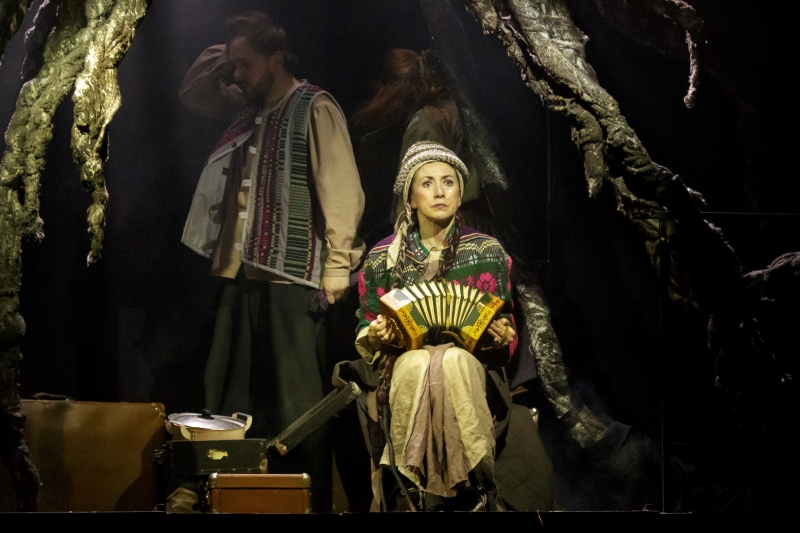
We view the events of the play through these childlike eyes – rural pre-war life suddenly interrupted by the horrors of occupation. It's worth noting that "Karney" is perhaps the most unusual embodiment of wartime events in Belarusian theater right now. The buffoonery style chosen by Alena Zmiter for "Karney" is most vividly expressed in the second, wartime part of the play.

The image of occupation is embodied here in an unusual, multifaceted monster – a grotesque caterpillar made of living beings, which slowly crawls across the stage, evoking both disgust and laughter from the audience, reminiscent of a creature from the cult trash-horror film "The Human Centipede."
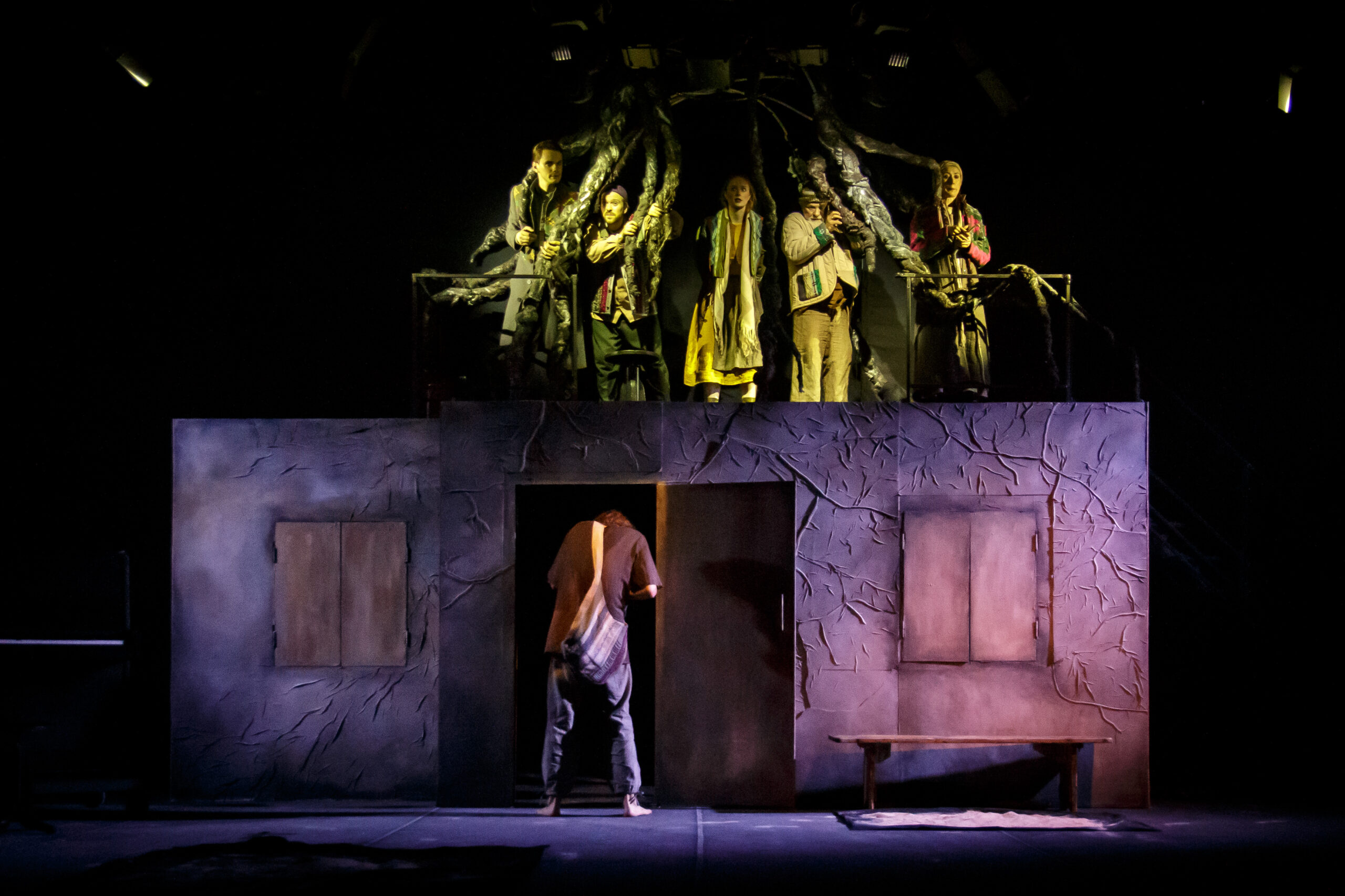
The visual imagery of the play is created by artist Marina Alekno. The conceptual nature of the production is emphasized by the set design. The relatively small stage of the Minsk Republican Theater of Belarusian Drama has been transformed into a complex space with multiple levels. The action unfolds on two levels: the peculiar battleground below – with humans, and the attic – inhabited by mice and rats. Interestingly, the rodents are also active characters here, perhaps even more crucial than the human characters. According to the staging concept, any rat is better than the punisher and the occupier.

When it comes to the concept, as Alena Zmiter mentioned in one of her interviews, "Karney" expresses both the conscious and unconscious aspects. The play, like its literary source, is challenging to categorize under realistic art forms. "Karney" embodies much of the unspoken, the essence for which actors pour their efforts into a full two and a half hours without an intermission.

Formally, Korotkevich's work can be classified as military prose. The theme of war in contemporary Belarusian theater is now a voluntary-compulsory one. However, the parable form allows for flexibility. At the Minsk Republican Theater of Belarusian Drama (RTBD), "Karney" is perceived not just as another war play. Nevertheless, the audience's reaction, patiently and attentively following the complex action throughout the evening without a break, is telling. As is often the case with RTBD productions lately, there's an exchange of emotions between the audience and actors, conveying unspoken and concealed feelings from both stage to hall and vice versa.

The character portrayed by Denis Avkharenko, along with the excellent ensemble of other actors, depicts not just the fate of an ordinary Belarusian but the fate of Belarus itself – unhappy, preoccupied with mundane concerns in rare peaceful times, and more often in difficult times of abuse and torture, silently moaning in horror. "Karney" can be considered a very good representation of the Belarusian character on stage – practical yet limited by personal trivialities. The vast world intrudes into "Karney's" narrative like an elemental force – war, catastrophe.

Alena Zmiter has directed several plays and staged readings at RTBD before "Karney," but they were generally much smaller in scale. "Karney" presents a complex scheme even for a more experienced director and is emotionally and physically demanding for the performers. It's worth mentioning, also for the audience. The cast of "Karney," including key figures like Anna Semenyako, Dmitry Davidovich, and Artem Kurenya, performs with incredible enthusiasm. The director proposed a very challenging, energetically saturated style of performance. The actors here emphasize their physical preparedness distinctly. There's not a single static pose or moment in their characters. It seems that Alena Zmiter has captured almost all of Meyerhold's gymnastics in "Karney." The play is highly dynamic in its movements on stage, in the development of the action, and in the associations it evokes in the audience.
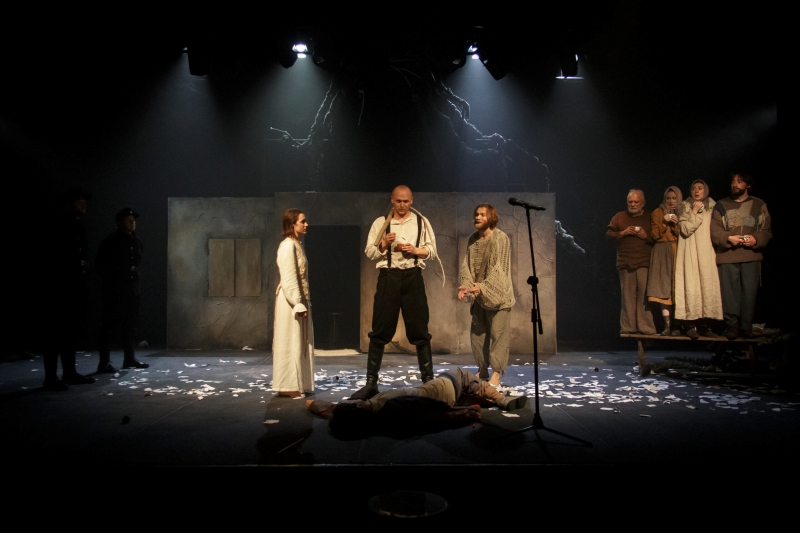
The characters here attempt to express what cannot be expressed in words. One of the standout moments is the interrogation of villagers by the executioners. Lined up in a demeaning manner, facing real terror, the RTBD actors do not simulate; they recall their personal emotions – we won't, we won't, we won't... And the audience feels this "we won't" not just with their ears but at a subconscious level, almost as their own. Horror emerges from somewhere, a cursed atavism, almost primordial – standing and trembling before executioners, occupiers, inhumane beings, the latest temporary rulers...
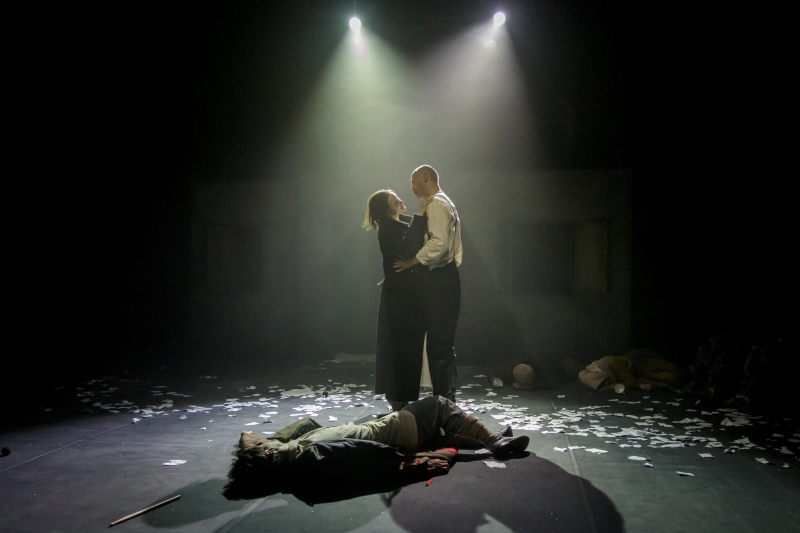
"Karney" demonstrates the inherent helplessness of Belarusians, their abandonment of personal dignity and subjectivity. And simultaneously, it offers a remedy for these typically national maladies. Only a divine man like Karney can seek revenge against the occupiers. He exacts revenge better than even the fairytale rat-catcher from medieval Hamelin. Karney's weakness and aloofness unexpectedly turn into strength, indecision into iron will, disarray into a steadfast purpose and its execution.

The play evokes conflicting emotions in the audience. Its structure appears disorganized, and the action seems almost chaotic. Compared to Alena Zmiter's previous productions based on contemporary playwrights, "Karney" surprises with its irrational approach to spectacle construction. Sometimes the action seems to hit a dead end and stall, while at other times it unfolds at incredible speed. The director clearly doesn't aim to make the viewing experience comfortable for the audience, as even non-commercial academic theaters do nowadays. Complex emotions overflow here.
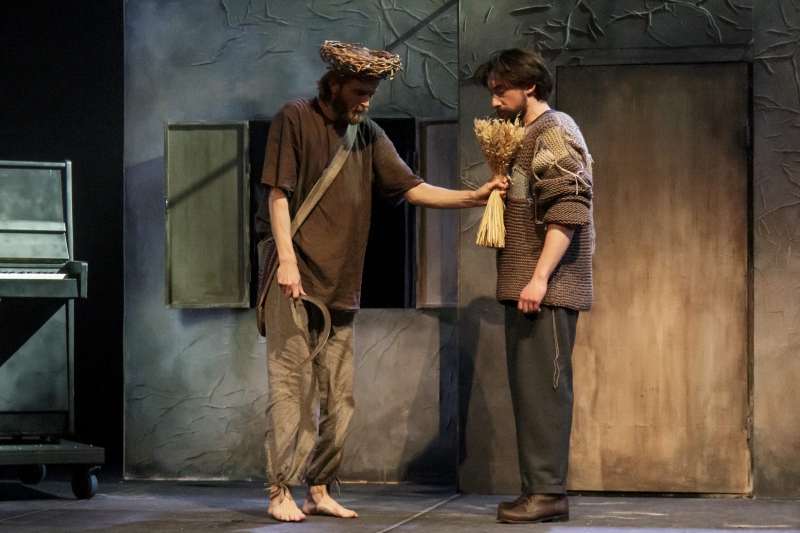
Трэба сказаць, «Карней – мышыная смерць» не адзіны твор Караткевіча, на якім заснаваны спектакль. Значны крок Алены Зміцер як творцы ў тым, што яе новая пастаноўка яшчэ і максімальна канцэптуальная для беларускага тэатра, які ўвесь час чамусьці спрабуе быць «бліжэй да гледача», чым на тое разлічвае сам глядач. Праўда, «Карней» менш за ўсё падобны на інтэлектуальны рэбус. Яго кірунак абсалютна зразумелы – стваральнікі прапануюць максімальна прасякнуцца спрадвечна нацыянальнай бядой. «Карней» – гранічна напружаны, насычаны вобразамі спектакль. У яго тканіну арганічна ўведзены фрагменты іншых твораў ды эсэ Уладзіміра Караткевіча. Нават дзея пачынаецца раней, чым глядач падымаецца ў залу: перад пачаткам у фае гучыць аўдыяпраект «Насіць сэрца дома з сабой».
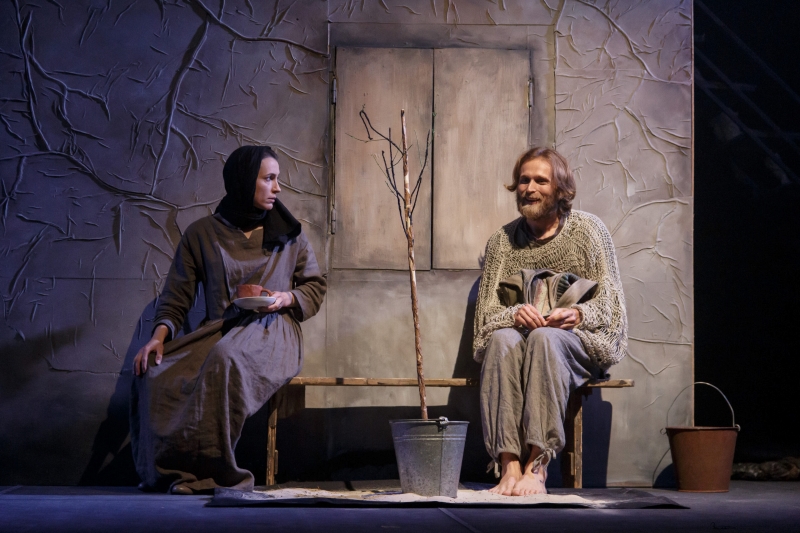
The image of home is not coincidentally central to Alena Zmiter's production, reflected in its title. The main character in Korotkevich's work spent his whole life striving for his own home. And when he finally almost achieves it, he is forced to destroy it himself.

"Karney," both literary and theatrical, only uses the familiar rat-catcher plot but actually showcases the drama of the Belarusian nation. How well Alena Zmiter and the RTBD team have achieved this is for the audience to decide. At least, the play has been running to full houses since summer, although it was also made available to everyone interested through online streaming. As for Korotkevich, he is the very support on which contemporary Belarusian theater rests. His figurative, lively language and plots have become even more interesting and relevant lately. Even the theatrical "Karney" concludes with the voice of the writer himself – an audio excerpt from the famous jubilee video recorded on November 28, 1980, "My Friends and Comrades!..".
Focusing on the writer's personality is not accidental here. Contemporary Belarusian theater in Belarus is about expressing oneself not just through words but through images, hints, and associations. This is what those who refuse to conform are doing now. Only spiritually and intellectually strong individuals can present something meaningful on the Belarusian stage in times of total fear and confusion. Just like Vladimir Korotkevich was.
Photo rtbd.b
ONLINE REPERTOIRE RTBDom









